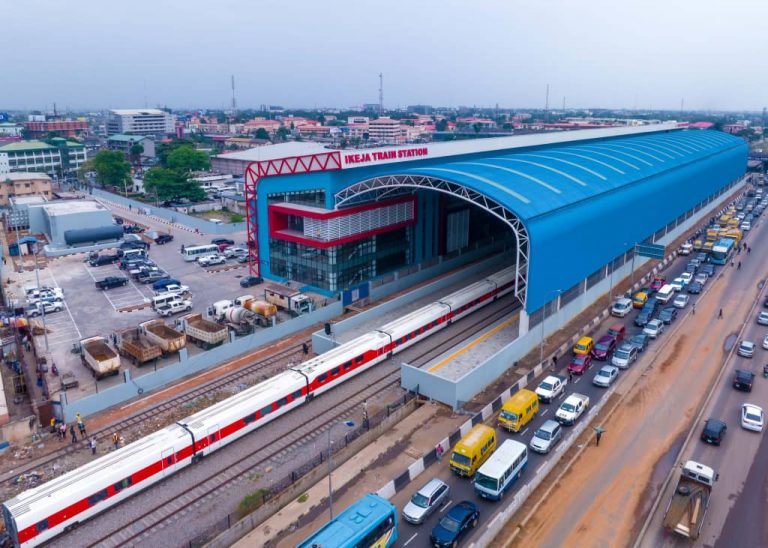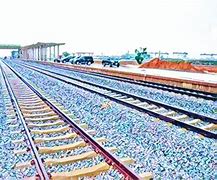In a bid to give the transport industry a big boast President Bola Tinubu has inaugurated the 37 kilometers Red Line rail system in Lagos, Nigeria.
The train is the first phase of the project, which will run from Agbado in Ogun State to Oyingbo in the heart of Lagos. When fully operational it will run 37 trips and convey about 500,000 passengers daily.
The commissioning signals the take-off of another major game changer in the state’s transportation infrastructure.
By the official commissioning of Ikeja Train Station the train is expected to reduce drastically travel time on the corridor, abate stress-induced health challenges and increase the productive capacity of the economy. It will also reduce traffic gridlock, road accidents and ensure the safety of commuters.
As part of the inter-modal connectivity of the public transportation infrastructure, the Redline is integrated with Bus Terminals at Ikeja, Oshodi, Oyingbo, Ikeja, Yaba and Iju.
To guarantee the safety of commuters and residents, the rail corridor has 10 vehicular overpasses and pedestrian bridges to separate the train from vehicular and pedestrian traffic.
No doubt, President Bola Tinubu who has spent less than one year in office has improved the transportation system in Nigeria.
Below are some key aspects of the Red Line Rail Project that must be noted and some insights into the new rail line.
It is very important to note that the Red Line Rail Project in Lagos, Nigeria, represents a significant infrastructure development aimed at improving transportation within the city.
The route: The Red Line is envisioned as a vital metro link within the Lagos-Ibadan rail corridor. Spanning 37 kilometres, it will share the right-of-way with the Lagos–Kano Standard Gauge Railway.
The route will initially run from Agbado in Ogun State to Oyingbo in Lagos, with notable stations including Agbado, Iju, Agege, Ikeja, Oshodi, Mushin, Yaba, and Oyingbo.
The project cost: The Red Line project is a substantial investment in Lagos’ urban transportation infrastructure. Initial estimates pegged the cost at $135 million under the Greater Lagos Urban Transportation Project, managed by the Lagos Metropolitan Area Transport Authority (LAMATA).
However, Governor Babajide Sanwo-Olu revealed that both the Blue and Red Lines combined would exceed ₦100 billion. Delays in the Blue Line project, initially expected to be completed by 2011, highlights the funding challenges faced by the project.
The operations: LAMATA, operating under the Ministry of Transportation, spearheads the Red Line Rail Project.
Once operational, it is expected to facilitate 37 trips daily, accommodating approximately 500,000 passengers.
The primary objectives include reducing travel time, mitigating health issues related to stress, and enhancing economic productivity.
The project aims to alleviate traffic congestion, minimise road accidents, and improve commuter safety within Lagos.
Choice of transmission:
The Red Line will utilise a diesel-powered system known as Diesel Multiple Unit (DMU), unlike the electric-powered Blue Line. DMU employs on-board diesel engines to propel multiple-unit trains. This choice of transmission aligns with the project’s objectives and operational requirements.
The Red Line Rail Project represents a significant milestone in Lagos’ transportation infrastructure development. Its inauguration promises to enhance connectivity, ease commuter burdens, and contribute to the city’s overall economic growth and development.
Infrastructure of the Red Line Rail
To ensure the smooth operation of the rail line and safety for commuters, significant infrastructure has been developed.
This includes the construction of 10 vehicular overpasses and pedestrian bridges, separating train traffic from vehicular and pedestrian flows.
In another development the FCT Minister, Mr Nyesom Wike and his team are allegedly working assiduously to ensure the Abuja light rail project as well as the ongoing construction of access roads to the train stations from Metro Train Station in Central Area to Nnamdi Azikiwe International Airport, Abuja are completed before May 29th.
This is to enable President Bola Tinubu commission the rail project on May 29th to mark his one year in office.
According to Wike President Bola Tinubu will ride on the Metro line by May 2024.
“We are working day and night to see that we fulfill; the promise we made to President Tinubu and residents of the FCT, that by May, Mr President will ride on the Metro line.
“We want to have access roads to the various train stations, because if you do not create access roads to the communities who will be using the train? Then the aim is defeated,’’ he said.
This is indeed a major project as it will reduce the influx of vehicles into the city.
While this momentum is highly applauded, the need to drive a country wide transport infrastructural master plan to ensure an integrated transport system anchored on a more robust and structured strategy is very important.
As other states join the fray, the economic impact will tremendously increase, boosting and accelerating the nation’s revenue generation. The Renewed Hope Agenda is building momentum and Nigeria is rising…
FG : Créer des alternatives au transport routier
Dans le but de donner une grande fierté à l’industrie des transports, le président Bola Tinubu a inauguré le système ferroviaire de la ligne rouge de 37 kilomètres à Lagos, au Nigeria.
Le train constitue la première phase du projet, qui reliera Agbado, dans l’État d’Ogun, à Oyingbo, au cœur de Lagos. Lorsqu’il sera pleinement opérationnel, il effectuera 37 voyages et transportera environ 500 000 passagers par jour.
La mise en service marque le décollage d’un autre changement majeur dans l’infrastructure de transport de l’État.
Avec la mise en service officielle de la gare d’Ikeja, le train devrait réduire considérablement le temps de trajet sur le corridor, atténuer les problèmes de santé induits par le stress et augmenter la capacité productive de l’économie. Cela réduira également les embouteillages et les accidents de la route et garantira la sécurité des navetteurs.
Dans le cadre de la connectivité intermodale de l’infrastructure de transport public, la Redline est intégrée aux terminaux de bus d’Ikeja, Oshodi, Oyingbo, Ikeja, Yaba et Iju.
Pour garantir la sécurité des navetteurs et des résidents, le corridor ferroviaire dispose de 10 passages supérieurs pour véhicules et de ponts piétonniers pour séparer le train de la circulation des véhicules et des piétons.
Il ne fait aucun doute que le président Bola Tinubu, qui est au pouvoir depuis moins d’un an, a amélioré le système de transport au Nigeria.
Vous trouverez ci-dessous quelques aspects clés du projet Red Line Rail qui doivent être notés ainsi que quelques aperçus de la nouvelle ligne ferroviaire.
Il est très important de noter que le projet Red Line Rail à Lagos, au Nigeria, représente un développement infrastructurel important visant à améliorer les transports au sein de la ville.
Le tracé : La ligne rouge est considérée comme une liaison métropolitaine vitale au sein du corridor ferroviaire Lagos-Ibadan. S’étendant sur 37 kilomètres, il partagera l’emprise avec le chemin de fer à voie standard Lagos-Kano.
L’itinéraire s’étendra initialement d’Agbado dans l’État d’Ogun à Oyingbo à Lagos, avec des stations notables telles qu’Agbado, Iju, Agege, Ikeja, Oshodi, Mushin, Yaba et Oyingbo.
Le coût du projet : Le projet Red Line représente un investissement substantiel dans les infrastructures de transport urbain de Lagos. Les premières estimations chiffraient le coût à 135 millions de dollars dans le cadre du projet de transport urbain du Grand Lagos, géré par la Lagos Metropolitan Area Transport Authority (LAMATA).
Cependant, le gouverneur Babajide Sanwo-Olu a révélé que les lignes bleue et rouge combinées dépasseraient 100 milliards de yens. Les retards dans le projet Blue Line, qui devait initialement être achevé d’ici 2011, mettent en évidence les défis de financement auxquels le projet est confronté.
Les opérations : LAMATA, qui relève du ministère des Transports, est le fer de lance du projet Red Line Rail.
Une fois opérationnel, il devrait faciliter 37 voyages quotidiens, accueillant environ 500 000 passagers.
Les principaux objectifs comprennent la réduction du temps de trajet, l’atténuation des problèmes de santé liés au stress et l’amélioration de la productivité économique.
Le projet vise à réduire les embouteillages, à minimiser les accidents de la route et à améliorer la sécurité des navetteurs à Lagos.
Choix de transmission :
La ligne rouge utilisera un système alimenté au diesel connu sous le nom d’unité multiple diesel (DMU), contrairement à la ligne bleue alimentée à l’électricité. DMU utilise des moteurs diesel embarqués pour propulser des trains à plusieurs unités. Ce choix de transport s’aligne sur les objectifs et les exigences opérationnelles du projet.
Le projet Red Line Rail représente une étape importante dans le développement des infrastructures de transport de Lagos. Son inauguration promet d’améliorer la connectivité, d’alléger le fardeau des navetteurs et de contribuer à la croissance et au développement économiques globaux de la ville.
Infrastructure de la Ligne Rouge
Pour assurer le bon fonctionnement de la ligne ferroviaire et la sécurité des navetteurs, d’importantes infrastructures ont été développées.
Cela comprend la construction de 10 passages supérieurs pour véhicules et ponts piétonniers, séparant le trafic ferroviaire des flux de véhicules et de piétons.
Dans un autre développement, le ministre du FCT, M. Nyesom Wike, et son équipe travailleraient assidûment pour assurer le projet de train léger sur rail d’Abuja ainsi que la construction en cours de routes d’accès aux gares ferroviaires depuis la gare de métro dans la zone centrale jusqu’à l’aéroport international Nnamdi Azikiwe. Abuja sont terminés avant le 29 mai.
L’objectif est de permettre au président Bola Tinubu de mettre en service le projet ferroviaire le 29 mai, à l’occasion de son premier an de mandat.
Selon Wike, le président Bola Tinubu prendra le métroligne d’ici mai 2024.
« Nous travaillons jour et nuit pour veiller à ce que nous nous épanouissions ; la promesse que nous avons faite au président Tinubu et aux habitants du FCT, que d’ici mai, M. le président prendra la ligne de métro.
« Nous voulons avoir des routes d’accès aux différentes gares, car si vous ne créez pas des routes d’accès aux communautés, qui utilisera le train ? Ensuite, l’objectif est raté », a-t-il déclaré.
Il s’agit en effet d’un projet majeur car il permettra de réduire l’afflux de véhicules dans la ville.
Bien que cet élan soit très applaudi, la nécessité de piloter un plan directeur d’infrastructure de transport à l’échelle nationale pour garantir un système de transport intégré ancré sur une stratégie plus robuste et structurée est très importante.
À mesure que d’autres États se joindront à la mêlée, l’impact économique augmentera considérablement ; stimuler et accélérer la génération de revenus du pays. Le programme Espoir renouvelé prend de l’ampleur et le Nigéria est en pleine croissance…



